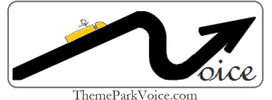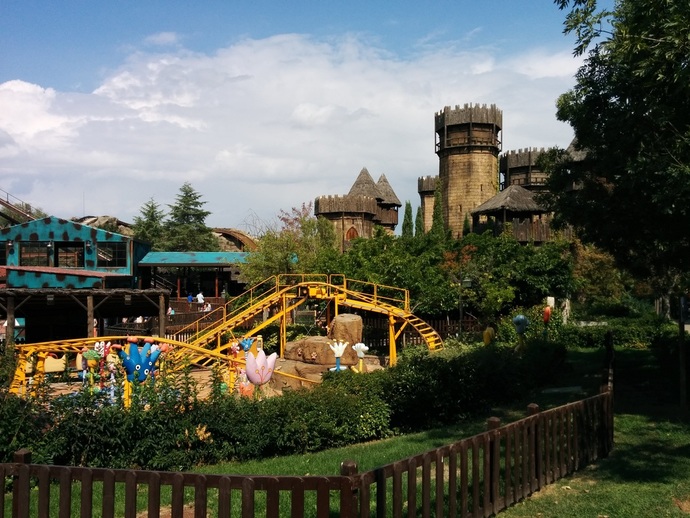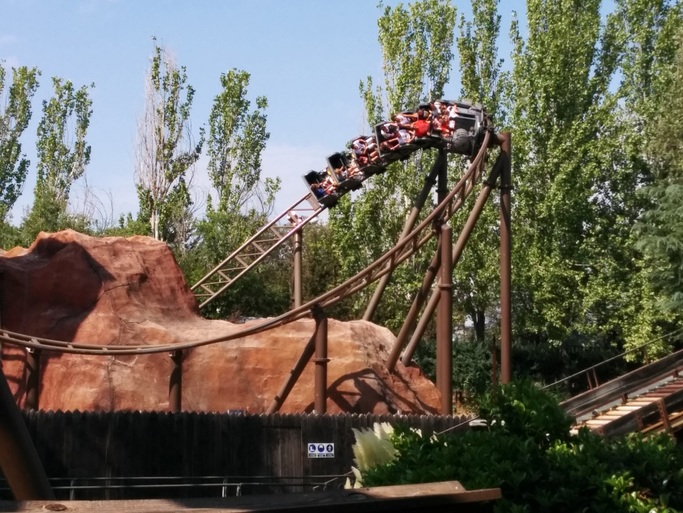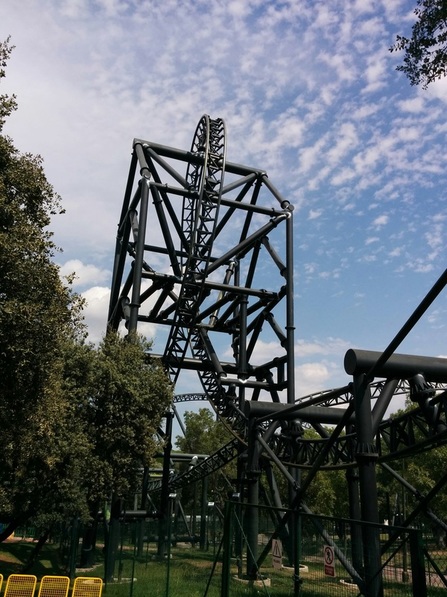Trip Reports
Parque de Atracciones de Madrid 04/09/2015
During my recent family holiday to Spain we spent four nights in Madrid, and on a Friday afternoon my sisters and I headed just outside of town to visit our first theme park of the trip. It must be admitted, Parque de Atracciones de Madrid is not blessed in the name department: it literally means “Madrid’s Theme Park”, but ‘a rose by any other name...’ and all that. It’s not a particularly big park in the grand scheme of things, but for a city-based park it’s gigantic. Parks like Gröna Lund in Stockholm and Tivoli Gardens in Copenhagen are shoehorned into tiny plots, with very little room for expansion, but on the other end of the spectrum parks like Disneyland Paris and Parque Warner Madrid (which we visited the following week), are not actually anywhere near their namesake cities. Parque de Attraciones is the perfect combination; there’s plenty of land for large rides, but it’s just a 15 minute metro journey from where we were staying (the metro station we used, Alonso Martinez, is very central), and the station at the park is right outside the entrance.
Spanish living hours are quite different to those in England; everything is shifted back about three hours, and Parque de Atracciones reflects this by only opening at midday. On a Friday the park was reasonably busy, but we didn’t have to wait for any more than 20 minutes for any ride.
Spanish living hours are quite different to those in England; everything is shifted back about three hours, and Parque de Atracciones reflects this by only opening at midday. On a Friday the park was reasonably busy, but we didn’t have to wait for any more than 20 minutes for any ride.
The Park
The entrance we used, by the metro station, isn’t actually the main entrance; it takes you into the back of the park by the Nickelodeonland area, which unsurprisingly caters to children. Being full of only kiddie rides, we quickly passed this and came across a castle, which serves as the entrance to relatively recent TNT Tren de la Mina coaster. It’s a Gerstlauer Mine Train, and it’s significantly larger than average. It’s a lot of fun; a great intermediate ride for older kids, and packs in some steep drops and banked curves. It’s a little short though, and after just a few dives the train hits the brakes. We ventured onwards to the actual front of the park, and next up was Vertigo. It’s a standard Wild Mouse coaster, built by Mack, and as they always are, it’s fast, fun and loaded with lateral g-force. The name is a bit misleading however; it’s only 46ft high. We had heard rumours that it garners the longest queues of any ride in the park, and this turned out to be correct: for some reason the operators insist on loading up all four trains, sending them round and waiting for them all to return to the station before loading them up again. This may be an overzealous safety precaution, but every other Wild Mouse I’ve been on just runs the trains continuously without issue. It’s especially surprising considering the ride was only built in 2009, and by Mack, who are a top manufacturer.
The entrance we used, by the metro station, isn’t actually the main entrance; it takes you into the back of the park by the Nickelodeonland area, which unsurprisingly caters to children. Being full of only kiddie rides, we quickly passed this and came across a castle, which serves as the entrance to relatively recent TNT Tren de la Mina coaster. It’s a Gerstlauer Mine Train, and it’s significantly larger than average. It’s a lot of fun; a great intermediate ride for older kids, and packs in some steep drops and banked curves. It’s a little short though, and after just a few dives the train hits the brakes. We ventured onwards to the actual front of the park, and next up was Vertigo. It’s a standard Wild Mouse coaster, built by Mack, and as they always are, it’s fast, fun and loaded with lateral g-force. The name is a bit misleading however; it’s only 46ft high. We had heard rumours that it garners the longest queues of any ride in the park, and this turned out to be correct: for some reason the operators insist on loading up all four trains, sending them round and waiting for them all to return to the station before loading them up again. This may be an overzealous safety precaution, but every other Wild Mouse I’ve been on just runs the trains continuously without issue. It’s especially surprising considering the ride was only built in 2009, and by Mack, who are a top manufacturer.
Abismo
We next headed into the “Maquinismo” zone (“Machinism”, whatever that means), which houses all of the park’s thrill rides. The flagship ride is Abismo (“Abyss”); a huge Maurer-Söhne Skyloop. These rides are quite common now, but very bizarre: the lift hill is the first half of a loop, and you are then dropped into the second half of the loop, going through a full barrel roll in the process, thus completing two inversions. They’re around 150ft tall, and use only lap bars, so riders are dangled fifteen stories in the air by just their waists. The other nine eaxmples of this model are identical to one another, they just complete the single large loop, dropping straight back into the station. Abismo takes the concept and adds a regular coaster layout at the end; the large loop-drop flows into an immelman inversion, before an extremely powerful airtime hill and an overbanked curve. The train is travelling so fast at this point that it rushes all the way through the station and up the first lift again in order to expend its excess energy. It is then brought slowly back to the station in reverse by the lift chain. It’s a visually stunning ride, the trains are fantastically comfortable, and it is both forceful and smooth. I’m truly surprised this longer layout hasn’t caught on.
We next headed into the “Maquinismo” zone (“Machinism”, whatever that means), which houses all of the park’s thrill rides. The flagship ride is Abismo (“Abyss”); a huge Maurer-Söhne Skyloop. These rides are quite common now, but very bizarre: the lift hill is the first half of a loop, and you are then dropped into the second half of the loop, going through a full barrel roll in the process, thus completing two inversions. They’re around 150ft tall, and use only lap bars, so riders are dangled fifteen stories in the air by just their waists. The other nine eaxmples of this model are identical to one another, they just complete the single large loop, dropping straight back into the station. Abismo takes the concept and adds a regular coaster layout at the end; the large loop-drop flows into an immelman inversion, before an extremely powerful airtime hill and an overbanked curve. The train is travelling so fast at this point that it rushes all the way through the station and up the first lift again in order to expend its excess energy. It is then brought slowly back to the station in reverse by the lift chain. It’s a visually stunning ride, the trains are fantastically comfortable, and it is both forceful and smooth. I’m truly surprised this longer layout hasn’t caught on.
Next to Abismo is La Lanzadera, the park’s Intamin drop tower. I’m a huge fan of these rides; I think they’re probably the best model of drop tower, and this version felt a lot taller than its billed 207ft. It’s a powerful drop, on par maybe even with Detonator at Thorpe Park, and so has become one of my favourite flat rides. Just as we got off the ride the heavens opened, and we sought shelter to eat some lunch. Surprisingly, literally every outdoor ride closed during the rain. Of course Spain doesn’t get as much rain as the UK, but it’s still fairly common, and to have all the external attractions out of action is quite a setback for guests. Luckily the park wasn’t very busy, and it blew over quickly.
La Maquina (The Machine) is a Frisbee-style ride, where you sit facing inwards on a rotating disk, which swings on a large pendulum. These rides are very common, and this looked like quite a small variant, so I wasn’t expecting much. It starts off quite energetically, generating a nice amount of tummy-lifting airtime at the top of each swing. But just at the point when you imagine it’ll start to wind down, it turns things up a notch and hugely increases the speed. For a couple of seconds this was pretty exhilarating, but it very quickly became too much; the g-force made it hard to hold your head up, and one person threw up immediately after exiting. It’s always refreshing to see a variant on a common ride model, but La Maquina was far too intense to be comfortable. Next to it is a much more generic Top Spin ride, inventively called Top Spin. I personally think these types of ride are fantastic, and although there was limited theming it still provided a fun, forceful ride cycle.
Tarantula
Tarantula is the park’s Maurer-Söhne (another one) spinning coaster, the same model as Sonic Spinball at Alton Towers and Crush’s Coaster at Disneyland Paris. This is bigger example than those two, but that doesn’t really work in its favour: these rides depend on tight turns and steep drops to keep the car spinning quickly (the trains spin freely, so it’s dependent on the distribution of passenger’s weight as well as how much the track itself turns). But despite the car remaining fairly still, the track is lengthy and it picks up enough speed to generate a good amount of force. These rides are prone to getting very large queues due to their universal appeal combined with small trains, but unlike on Vertigo the operations were excellent, and so it’s well worth a few re-rides.
Tarantula
Tarantula is the park’s Maurer-Söhne (another one) spinning coaster, the same model as Sonic Spinball at Alton Towers and Crush’s Coaster at Disneyland Paris. This is bigger example than those two, but that doesn’t really work in its favour: these rides depend on tight turns and steep drops to keep the car spinning quickly (the trains spin freely, so it’s dependent on the distribution of passenger’s weight as well as how much the track itself turns). But despite the car remaining fairly still, the track is lengthy and it picks up enough speed to generate a good amount of force. These rides are prone to getting very large queues due to their universal appeal combined with small trains, but unlike on Vertigo the operations were excellent, and so it’s well worth a few re-rides.
After this, since the sun was out once again, we took a trip on the log flume, Aserradero. It looks fairly mild, but we could clearly see from the people exiting the ride that it absolutely drenches you. I don’t really mind this; it’s a water ride after all, and it’s especially acceptable when the sun is out. But most of the wetness comes from the boat itself: as soon as we climbed the first lift, all the water from the floor flooded back through our shoes. There’s a waterfall feature which doesn’t turn off as you pass under it, and the final drop adds a nice coating of muddy water to your trousers. Adding insult to injury, you have to take any baggage on the ride with you. It’s an appalling attraction; I truly can’t think of a less pleasant water ride.
Tornado
Tornado was for a long time the park’s most significant ride, until it was usurped by Abismo, and on paper it’s still an impressive attraction. It’s an inverted coaster with three inversions, but whilst these rides are usually built by either B&M or Vekoma (the former being far more highly regarded than the latter), this one is built by Intamin. Intamin is vastly experienced, and does build a range of launched inverted coasters, but this is a standard lift-hill model, and the fact that only two of these ever got built, the most recent in 2001, is testament to their quality. Simply, Tornado is quite dull. It has a reasonable layout; a swinging first drop is followed by a pair of loops, which sandwich an overbanked curve. There’s then a typically painful Intamin corkscrew before a large helix and the final brakes. It’s a shame that such a large investment delivered so little, but it’s lasted a while and served its purpose, and I think it’s about time it were replaced with a more successful model, inverted or otherwise. We had absolutely no desire to ride it again, despite there being next-to-no queue.
Tornado
Tornado was for a long time the park’s most significant ride, until it was usurped by Abismo, and on paper it’s still an impressive attraction. It’s an inverted coaster with three inversions, but whilst these rides are usually built by either B&M or Vekoma (the former being far more highly regarded than the latter), this one is built by Intamin. Intamin is vastly experienced, and does build a range of launched inverted coasters, but this is a standard lift-hill model, and the fact that only two of these ever got built, the most recent in 2001, is testament to their quality. Simply, Tornado is quite dull. It has a reasonable layout; a swinging first drop is followed by a pair of loops, which sandwich an overbanked curve. There’s then a typically painful Intamin corkscrew before a large helix and the final brakes. It’s a shame that such a large investment delivered so little, but it’s lasted a while and served its purpose, and I think it’s about time it were replaced with a more successful model, inverted or otherwise. We had absolutely no desire to ride it again, despite there being next-to-no queue.
The Rest of the Park
StarFlyers, which are effectively chair swings that lift passengers up to dizzying heights, have become ubiquitous across the world. Virtually every Six Flags and Cedar Fair park has one now, and there’s even one on the South Bank next to the London eye currently. It’s easy to understand why; they take up a tiny foot print and they’re impressively tall, but they’re not intense enough to put off timid riders. Parque de Atracciones’ version is the standard 80m (262ft) model built by FunTime, and it’s thoroughly enjoyable. I wasn’t a big fan of the model before this one; they’re so high up they get very cold and windy (in the UK at least), whilst being a little unsettling since you’re attached only by chains. But in the Spanish summer sun it was wonderful, it gives great views of both the park and of Madrid, and it was still high enough that it’s not boring.
StarFlyers, which are effectively chair swings that lift passengers up to dizzying heights, have become ubiquitous across the world. Virtually every Six Flags and Cedar Fair park has one now, and there’s even one on the South Bank next to the London eye currently. It’s easy to understand why; they take up a tiny foot print and they’re impressively tall, but they’re not intense enough to put off timid riders. Parque de Atracciones’ version is the standard 80m (262ft) model built by FunTime, and it’s thoroughly enjoyable. I wasn’t a big fan of the model before this one; they’re so high up they get very cold and windy (in the UK at least), whilst being a little unsettling since you’re attached only by chains. But in the Spanish summer sun it was wonderful, it gives great views of both the park and of Madrid, and it was still high enough that it’s not boring.
Since we had spent so little time queuing, we finished all the obvious rides by about 4:30, and so we decided to get on some rides that might’ve skipped with more time pressure. Robin Hood is a 4D cinema; showing a 3D film whilst periodically tickling your legs with air blowers, squirting your face with mist and poking you with pneumatic rods. The cinema itself was very dilapidated (come to think of it, I don't think there were pneumatic rods...), and the 3D technology was dire, but the film was quite good: there’s no dialogue at all to avoid the whole “Spanish or English?” dilemma, but the plot is engineered to be entertaining and very easy to follow. As you’d imagine with Robin Hood, there’s plenty of swashbuckling, arrow-shooting and maiden-rescuing. It lasts a total of about 15 minutes, which is just enough for it to remain interesting whilst also being worthwhile for the queue time.
Last up was another projection based ride, a simulator this time, which had an original comedy/sci-fi theme. Once again the film was rather good considering it wasn’t based around any intellectual property; a fast food vendor on a busy space-road in a huge vertical space-city accidentally damages a woman’s car by spilling his food, and proceeds to chase her down to help her. She sees this as an unwanted romantic advance (I guess that’s the problem with not having any dialogue) and tries to escape. Eventually her car breaks down completely and he manages to save her from falling out of the sky. Again, it’s around the 15 minute mark, but in this case it’s too long: the simulator system is very violent and the rocking motion of the carriage soon becomes quite painful. It’s also not particularly synchronised with or relevant to what’s happening on screen; basically any motion of the onscreen vehicle is met by wild shaking of the actual carriage, even if nothing significant is happening. Often the camera shot isn’t even within the vehicle, so it’s not actually simulating anything. It’s another ride that could do with a refurbishment, and isn’t worth more than a 10 minute wait.
Overall the park has a large range of attractions, some very good but some very bad. They’ve installed plenty of family and kiddie rides recently, but the larger rides and the indoor attractions need some tender loving care. Tornado has gone well past its use-by date, both the 4D cinema and the simulator need major overhauls, and the log flume should be burnt to the ground. But on the bright side Abismo, Tarantula and La Lanzadera (the drop tower) are all solid attractions, and considering how easy the journey is from central Madrid, the park is well worth a visit if you have a spare afternoon in the city.
Abismo and La Lanzadera: 8/10
StarFlyer: 7/10
Tarantula and Top Spin: 6.5/10
Tornado, Tren de la Mina, Vertigo: 5/10
Robin Hood, Simulator Ride: 4/10
Log Flume: 2/10
Overall: 6/10
Last up was another projection based ride, a simulator this time, which had an original comedy/sci-fi theme. Once again the film was rather good considering it wasn’t based around any intellectual property; a fast food vendor on a busy space-road in a huge vertical space-city accidentally damages a woman’s car by spilling his food, and proceeds to chase her down to help her. She sees this as an unwanted romantic advance (I guess that’s the problem with not having any dialogue) and tries to escape. Eventually her car breaks down completely and he manages to save her from falling out of the sky. Again, it’s around the 15 minute mark, but in this case it’s too long: the simulator system is very violent and the rocking motion of the carriage soon becomes quite painful. It’s also not particularly synchronised with or relevant to what’s happening on screen; basically any motion of the onscreen vehicle is met by wild shaking of the actual carriage, even if nothing significant is happening. Often the camera shot isn’t even within the vehicle, so it’s not actually simulating anything. It’s another ride that could do with a refurbishment, and isn’t worth more than a 10 minute wait.
Overall the park has a large range of attractions, some very good but some very bad. They’ve installed plenty of family and kiddie rides recently, but the larger rides and the indoor attractions need some tender loving care. Tornado has gone well past its use-by date, both the 4D cinema and the simulator need major overhauls, and the log flume should be burnt to the ground. But on the bright side Abismo, Tarantula and La Lanzadera (the drop tower) are all solid attractions, and considering how easy the journey is from central Madrid, the park is well worth a visit if you have a spare afternoon in the city.
Abismo and La Lanzadera: 8/10
StarFlyer: 7/10
Tarantula and Top Spin: 6.5/10
Tornado, Tren de la Mina, Vertigo: 5/10
Robin Hood, Simulator Ride: 4/10
Log Flume: 2/10
Overall: 6/10







